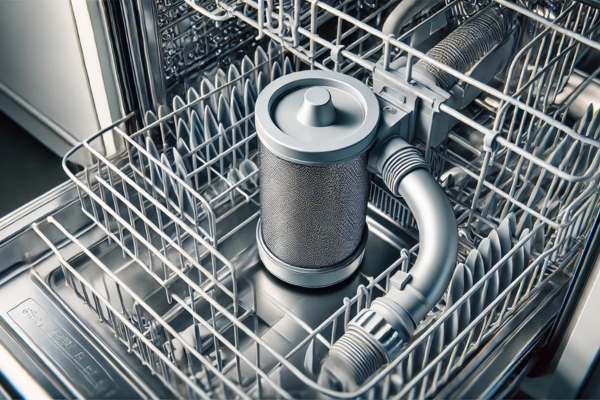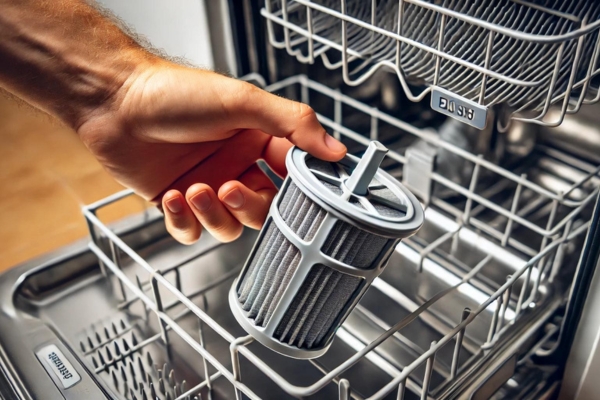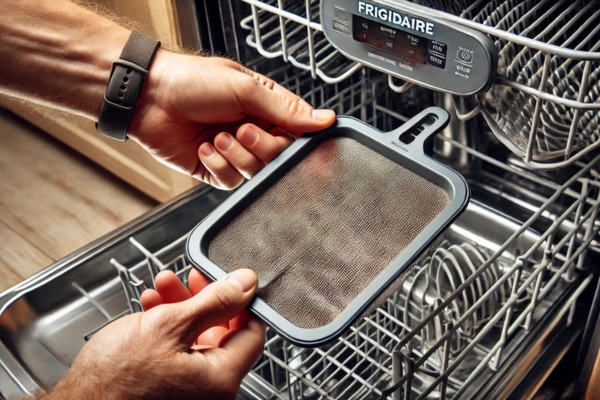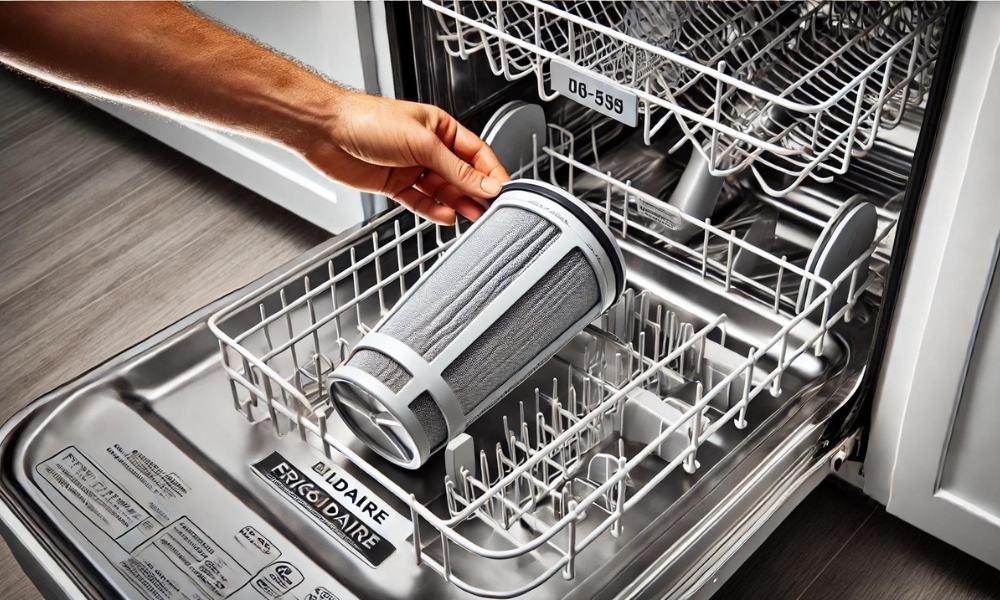Owning a Frigidaire dishwasher filter is a game-changer in the daily battle against dirty dishes, turning a mundane chore into a seamless, almost effortless task. Behind this marvel of modern convenience, however, lies a hidden hero – the filter. Unseen, often forgotten, but undeniably crucial, this small component stands guard over your dishwasher’s performance. Without it, things can go south quickly. Plates may emerge with a stubborn film, and glasses? Not quite the sparkle you’re after. Understanding where your dishwashers filter resides and giving it the care it deserves can mean the difference between years of optimal use and frustrating inefficiency.
Understanding Your Frigidaire Dishwasher
Your Frigidaire dishwasher, at its essence, is a symphony of technology working in concert. Water pressure, the right dose of detergent, and heat all collaborate to clean your dishes to a spotless finish. But none of these elements would work as effectively without the strainer capturing rogue food particles and debris. Without the filter’s steady hand, dirty water would cycle back through, leaving your dishes far from clean. Recognizing the role the filter plays not only elevates your understanding of how your dishwashers work but emphasizes the importance of regular maintenance.
Why Knowing Your Dishwasher Filter Location Matters
Beneath the gleaming exterior of your Frigidaire dishwasher, the strainer quietly goes about its business, often unnoticed, yet essential. Situated deep within the machine, the filter’s job is simple: trap food remnants, prevent them from redepositing, and maintain the cleanliness of every cycle. Knowing where this filter is located helps you stay on top of routine cleaning, but it does more than that. It empowers you to address any performance hitches before they escalate. A well-maintained strainer keeps your dishes sparkling and your machine running smoothly; a clogged one, however, spells trouble.
The Basics Of Dishwasher Filters
Dishwasher filters may appear inconsequential, a mere footnote in the grand scheme of kitchen technology. However, they serve as the backbone of your appliance’s effectiveness. By capturing food particles, grease, and debris, filters prevent your machine from circulating contaminated water. Most modern dishwashers, Frigidaire included, come with either self-cleaning or manual filters. Self-cleaning versions boast a grinder that breaks down food debris, while manual ones require your intervention. Regular maintenance ensures that the filter doesn’t become a point of failure.
The Role Of A Filter In Your Frigidaire Dishwasher’s Performance
In your Frigidaire dishwasher, the filter is the unsung hero. Ensuring that water remains free of debris throughout the wash cycle, it maintains optimal cleaning conditions. Without this filter working its magic, debris would quickly clog the system, resulting in dish loads that are anything but pristine. Over time, a neglected strainer leads to diminished performance, longer cycle times, and possibly even damage to the machine’s internal components. Proper strainer care isn’t just about clean dishes; it’s about ensuring your dishwashers perform to the best of its ability, cycle after cycle.
Common Signs Your Dishwasher Filter Needs Attention
Your dishwasher, like any machine, gives warning signs when something’s off. Murky water, food particles left behind on dishes, or a strange, lingering odor are red flags that your filter may need attention. A clogged filter can also cause your dishwashers to become noisier or slow down during a cycle. If these symptoms crop up, your strainer is likely in need of a thorough cleaning. Neglecting these signals could result in more serious issues down the line, so it’s best to act promptly.
The Different Types Of Filters In A Frigidaire Dishwasher
Not all filters are created equal. In Frigidaire dishwashers, you’ll find two main types: self-cleaning and manual filters. Self-cleaning filters come equipped with a grinder that breaks down food particles and flushes them away, while manual filters catch the debris in a basket, requiring regular cleaning. Understanding which type of strainer your dishwashers use helps you maintain it more effectively, ensuring long-term functionality without any hiccups.
Location Of The Filter In Different Frigidaire Dishwasher Models
The filter’s location can vary depending on the Frigidaire model you own. Generally, though, filters are located at the base of the dishwasher’s tub. Some are found beneath the spray arm, while others sit behind a detachable panel. It’s essential to familiarize yourself with the specific layout of your dishwashers to find and maintain the strainer. While older models may require more effort to access, newer designs make this task much simpler.
How To Locate The Filter In Older Frigidaire Dishwasher Models
Older models of Frigidaire dishwashers often have filters hidden in harder-to-reach places. The filter might be tucked away under the spray arm or concealed by a small, removable cover. Accessing it requires turning off the machine and sometimes even removing a few components. Yet, once you familiarize yourself with the layout, it becomes a relatively straightforward process. Always ensure the machine is powered down to avoid accidents while removing parts.
Finding The Filter In Newer Frigidaire Dishwasher Models
In contrast to older models, newer Frigidaire dishwashers have made filter maintenance more user-friendly. The filter is often situated near the base, secured under a twist-off cover. No tools required—just a quick twist, and the strainer is ready to be cleaned or replaced. If you’re unsure where to begin, your user manual provides diagrams and step-by-step instructions tailored to your model.
How To Safely Access The Filter In A Frigidaire Dishwashers
Safety first: before attempting to access the filter, unplug your dishwashers or switch off its power supply. You’ll usually need to remove the bottom dish rack to expose the filter. Look for a cylindrical or flat screen near the bottom spray arm. Twist or pull gently to remove it. Take care not to damage any surrounding parts, as a filter mishap could disrupt the entire cleaning process.
Step-By-Step Guide To Removing The Filter
1. Unplug The Dishwashers Or Turn Off Its Power

Safety is paramount. Before beginning any work on your dishwasher, make sure to either unplug the unit or switch off its power supply at the breaker. This ensures no electrical mishaps while you’re working inside the appliance.
2. Slide Out The Bottom Rack To Clear The Way

The next step involves creating space. Gently pull the bottom dish rack out and set it aside, exposing the base of the dishwasher. This will give you clear access to the strainer area without any obstruction.
3. Locate The Filter—Often Near The Spray Arm

Look at the bottom of the dishwasher. The strainer is usually located near the bottom spray arm, a cylindrical or mesh component designed to trap food particles and debris. Depending on your model, it could be slightly hidden under a cover.
4. Twist It Counterclockwise, Then Lift It Out Carefully

Once located, grip the filter gently. Twist it counterclockwise to release it from its housing. Avoid using excessive force, as this could damage the strainer or its surrounding components. Slowly lift the strainer out of the dishwashers.
5. Remove Any Secondary Filters For A Thorough Cleaning

Some Frigidaire dishwashers come with a secondary mesh strainer beneath the main one. If your model has this, remove it as well. This allows you to clean both filters thoroughly, ensuring no debris remains inside the machine.
What To Do If You Can’t Find The Filter
If the strainer remains elusive, consult the user manual specific to your Frigidaire model. The diagrams and instructions provided will offer clarity. If the manual doesn’t help, explore online forums or reach out to Frigidaire’s customer service for further guidance.
Cleaning The Filter: A Simple Maintenance Task
Once removed, the filter should be rinsed under warm water to wash away food debris and grease. For stubborn dirt, a soft brush can help scrub it clean. Avoid harsh chemicals, as they may damage the strainer material. Regular cleaning not only keeps your dishwasher running smoothly but also extends the lifespan of the machine.
How Often Should You Clean Your Frigidaire Dishwasher Filter?
The frequency of strainer cleaning largely depends on how often you use your dishwasher. If you run cycles daily, a monthly cleaning is advisable. Households with less frequent use may get away with cleaning it every two to three months. A clean strainer equals better performance, so don’t neglect this small but significant task.
Signs Your Filter Needs Replacement Instead Of Cleaning
Sometimes cleaning isn’t enough. If your dishwasher filter looks worn, has cracks, or no longer seems to catch debris effectively, it may need to be replaced. When in doubt, inspect the strainer for any visible damage, and if performance hasn’t improved after cleaning, it’s time to purchase a new one.
Choosing The Right Replacement Filter For Your Frigidaire Dishwasher
Not all filters are interchangeable. It’s vital to select a replacement strainer designed for your specific Frigidaire model. Using an incorrect strainer could compromise performance or even damage the machine. When buying a replacement, ensure it matches your model by checking the product number or consulting Frigidaire’s parts guide.
Where To Buy Replacement Filters For Frigidaire Dishwashers
Replacement filters are readily available online through Frigidaire’s official website or at appliance stores. It’s important to buy from reputable sources to guarantee compatibility. While generic filters may be cheaper, they often fall short in terms of performance and durability.
Preventing Future Problems With Regular Filter Maintenance
A well-maintained strainer means fewer dishwasher problems down the road. Clean it regularly, and you’ll avoid clogs, prevent unnecessary strain on the machine, and ensure your dishes emerge spotless. Filter maintenance may seem trivial, but it plays a significant role in your dishwasher’s long-term health.
Other Parts Of Your Frigidaire Dishwasher You Should Maintain
Beyond the strainer, other components like the spray arms, drain, and detergent dispenser also need attention. These parts can accumulate grime, grease, or calcium deposits, affecting overall performance. Periodic cleaning of all these elements ensures your dishwasher continues to function optimally.
How A Clean Filter Improves Dishwasher Efficiency
A clean strainer allows water to flow freely and efficiently, ensuring that your dishes are thoroughly cleaned without residue. This improved efficiency also means your dishwasher uses less energy and water, which in turn prolongs the lifespan of your appliance.
What Happens If You Don’t Clean Your Frigidaire Dishwasher Filter?
Neglecting the strainer can lead to bigger issues. Over time, food particles accumulate, clogging the system and reducing water flow. This results in dirty dishes, foul odors, and, eventually, potential damage to the dishwasher itself. Ignoring strainer maintenance can turn a simple fix into a costly repair.
Simple Tips To Keep Your Dishwasher Running Like New
In addition to regular strainer cleaning, periodically running an empty cycle with vinegar or a specialized dishwasher cleaner can help break down grease and calcium deposits. Also, avoid overloading the dishwasher and use the recommended amount of detergent to keep your machine working efficiently.
Troubleshooting Other Common Frigidaire Dishwasher Issues
Odd noises? Incomplete cycles? Your Frigidaire dishwasher may face issues unrelated to the strainer. Identifying the cause early on can save you from future headaches. Check your manual for troubleshooting tips or consult a professional if the issue persists beyond a simple strainer clog.
When To Call A Professional For Dishwasher Repair
If problems persist even after thorough strainer maintenance, it may be time to call in a professional technician. A skilled expert can diagnose more serious issues, such as motor or electrical faults, and offer the repairs needed to get your dishwasher back in top shape.
Final Thoughts
Caring for your Frigidaire dishwasher filter is a straightforward but crucial task. With regular maintenance and attention, you’ll ensure your dishwasher continues to deliver clean, sparkling dishes every time, extending its life and performance for many years to come.
